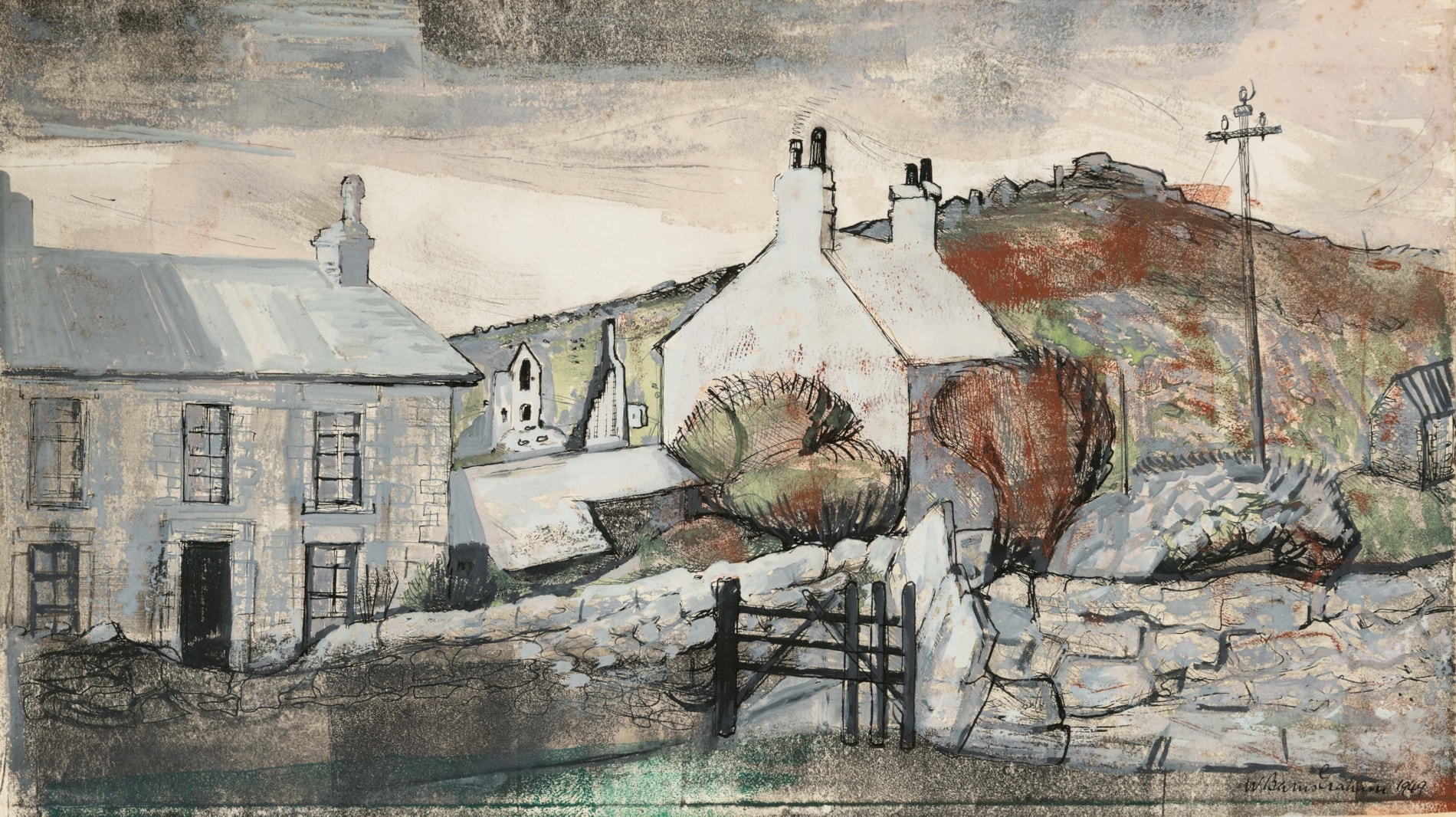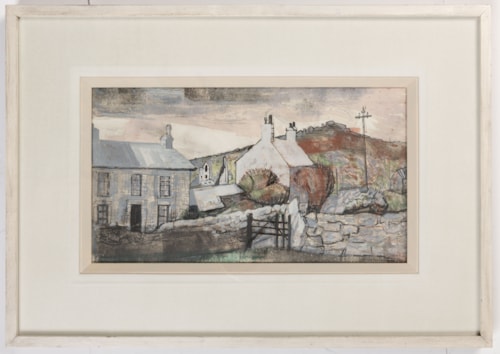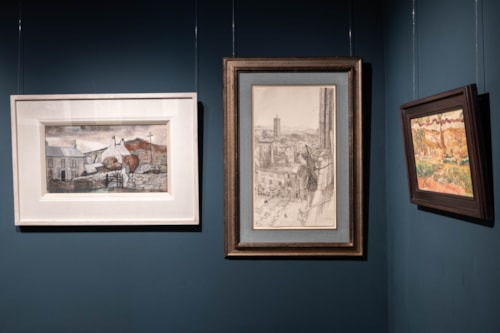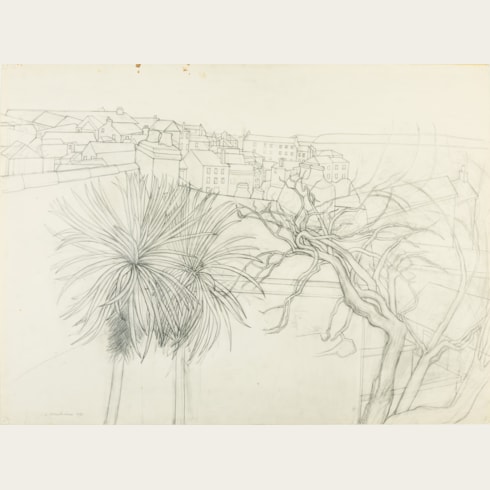Wilhelmina BARNS-GRAHAM
(St. Andrews 1912 - St. Andrews 2004)
Gurnard’s Head, Cornwall, in Winter
Watercolour, gouache, ink and coloured chalk on paper, laid down.
Signed and dated W. Barns Graham 1949. at the lower right.
Inscribed Gurnards Head, (Winter) / W. Barns-Graham 1949 / 11 1/8” x 20 1/4”. / CAT NO. 11/49/0, and further inscribed exhibited Castle Inn St Ives 1949 on the backing board.
255 x 452 mm. (10 x 17 3/4 in.)
Signed and dated W. Barns Graham 1949. at the lower right.
Inscribed Gurnards Head, (Winter) / W. Barns-Graham 1949 / 11 1/8” x 20 1/4”. / CAT NO. 11/49/0, and further inscribed exhibited Castle Inn St Ives 1949 on the backing board.
255 x 452 mm. (10 x 17 3/4 in.)
Wilhelmina Barns-Graham was a draughtsman of considerable talent. Her drawings were admired by Ben Nicholson, with whom she shared a similar approach to the depiction of landscape in her works on paper, and the two artists often went on sketching expeditions together. As an obituary of Barns-Graham claimed, ‘As a draughtsman she was second only to Nicholson himself, and was more versatile. Her crisp drawings of rocks, landscapes and buildings continued to underpin all her other work.’ As the artist herself stated in 1989, ‘I have always been interested in drawing and have spent considerable time constructing my compositions…After sessions of drawing, I turn my back on the experience and return to painting in the abstract, where there is a meeting point of abstracted ideas. This swing between outward observation and inward perception, or vice versa, has always increased my awareness.’ A few years later, she added, ‘There is a great excitement and tension before beginning a drawing. The element of shock from the blank paper, the choice of medium, different kinds of pencils on various makes of paper, use of charcoal or chalk, pen and ink or a stick dipped in indian ink. I have always been interested in drawing – it is a discipline of the mind.’
Drawn in 1949, the year that Barns-Graham resigned from the more traditional St. Ives Society of Artists to become one of the founders of the Penwith Society of Arts, the present sheet depicts the 17th century coaching inn known as the Gurnard’s Head, situated near the rocky promontory of the same name on the north coast of the Penwith peninsula in Cornwall, just north of Porthmeor and about six miles west of St. Ives. (The name apparently derives from the headland’s resemblance to the head of a gurnard fish.) A comparable gouache study of the Gurnard’s Head, dated two years earlier in 1947 and of slightly larger dimensions, was recently acquired for the Penlee House Gallery and Museum in Penzance. An oil painting of Gurnard’s Head, also dated 1947, is in the collection of the Wilhelmina Barns-Graham Trust in Edinburgh.
A recent owner of the present sheet was the Cornish businessman, Labour politician and collector Paul Myners, Baron Myners CBE (1948-2022). A trustee of the Tate, the National Maritime Museum and the Royal Academy, Myners assembled a fine collection of paintings, sculptures and ceramics by artists who worked in St. Ives and Cornwall.
Drawn in 1949, the year that Barns-Graham resigned from the more traditional St. Ives Society of Artists to become one of the founders of the Penwith Society of Arts, the present sheet depicts the 17th century coaching inn known as the Gurnard’s Head, situated near the rocky promontory of the same name on the north coast of the Penwith peninsula in Cornwall, just north of Porthmeor and about six miles west of St. Ives. (The name apparently derives from the headland’s resemblance to the head of a gurnard fish.) A comparable gouache study of the Gurnard’s Head, dated two years earlier in 1947 and of slightly larger dimensions, was recently acquired for the Penlee House Gallery and Museum in Penzance. An oil painting of Gurnard’s Head, also dated 1947, is in the collection of the Wilhelmina Barns-Graham Trust in Edinburgh.
A recent owner of the present sheet was the Cornish businessman, Labour politician and collector Paul Myners, Baron Myners CBE (1948-2022). A trustee of the Tate, the National Maritime Museum and the Royal Academy, Myners assembled a fine collection of paintings, sculptures and ceramics by artists who worked in St. Ives and Cornwall.
The Scottish painter, draughtsman and printmaker Wilhelmina (always known as ‘Willie’ to friends) Barns-Graham was born in St. Andrews in Fife and studied at the Edinburgh College of Art between 1931 and 1937, her tenure sometimes interrupted by recurring health issues caused by weak lungs. While at the College she earned several awards and travel scholarships, and had her work included in the annual Summer Exhibitions of the Royal Scottish Academy. In March 1940, the twenty-seven-year-old artist moved to St. Ives in western Cornwall, where she met Ben Nicholson, Barbara Hepworth and Naum Gabo, as well as the local ‘primitive’ painter Alfred Wallis and the potter Bernard Leach. Barns-Graham was to maintain a studio in St. Ives for the rest of her long career of almost eight decades. In 1942 she became a member of the St. Ives Society of Artists and the Newlyn Society of Artists, exhibiting paintings influenced by Cornish landscapes at both institutions between 1942 and 1949.
After participating in numerous group exhibitions in Cornwall and Edinburgh, Barns-Graham had her first solo exhibition at the Downing Gallery in St. Ives in 1946, followed by a second show there two years later. In 1949 she left the St. Ives Society of Artists and became a founding member of the more progressive breakaway group, the Penwith Society of Artists, where she was to exhibit regularly for the next fifty years. Her work began to be included in group shows in London and she also spent some time in Grindelwald in Switzerland, inspiring a series of paintings, drawings and gouaches of glaciers, executed between 1948 and 1952. In 1950 Barns-Graham’s painting Upper Glacier was acquired by the British Council, and the following year her large painting Porthleven won the St. Ives Festival of Britain prize for painting, while in the same year her work was included in Herbert Read’s book Contemporary British Art.
In 1952 Barns-Graham had her first solo exhibition in London, at the Redfern Gallery. Her travels took her to Paris, Venice and Tuscany, and by 1956 her work was regularly being exhibited in London and she was briefly on the staff of the Leeds School of Art. Although she was fully integrated into the modernist milieu of St. Ives, with the arrival of artists such as Peter Lanyon, Roger Hilton, Terry Frost and Bryan Winter, Barns-Graham often felt at a disadvantage in the competition for recognition and contacts with dealers in London and abroad. She was also unfairly regarded, by some critics and scholars, as a relatively minor member of the St. Ives school. (This imbalance was confirmed when the Tate Gallery’s 1985 exhibition St. Ives 1939-64: Twenty-Five Years of Painting, Sculpture and Pottery included only three works by Barns-Graham, while Lanyon and Hilton were represented by nineteen and twenty paintings, respectively.) In 1960 Barns-Graham began to divide her time between Cornwall and Scotland, having inherited a house near St. Andrews. (She also rented a studio in London between 1961 and 1963.) In St. Ives in 1963 she moved into a studio on Porthmeor Beach, and by the mid 1960s had begun to work in a severely geometrical mode of abstraction, while at the same time continuing to produce representational work, particularly landscapes.
Throughout the 1960s, 1970s and 1980s Barns-Graham’s paintings were shown widely in galleries in Cornwall, London and Scotland, as well as in touring group exhibitions organized by the Arts Council. Although by this time her reputation was largely established as an abstract artist, she continued to paint representational subjects, notably the Cornish landscapes that had been the subject of her first solo exhibitions. (The artist’s landscapes, which later included views of Scotland, Italy and Switzerland, often in turn led to more abstract compositions.) The late 1980s found Barns-Graham producing a vast array of freely-painted, colourful abstract paintings, usually executed on paper rather than canvas, as well as screenprints, which introduced her work to a new audience and market. In 1989 a retrospective exhibition comprising fifty years of her work was held in museums in Penzance, Edinburgh, St. Andrews, Perth and Ayr, followed three years later by another travelling exhibition on the occasion of the artist’s eightieth birthday. As she stated in 2001, the same year that she was awarded a CBE and a major monograph on her work appeared, ‘In my paintings I want to express the joy and importance of colour, texture, energy and vibrancy, with an awareness of space and construction. A celebration of life.’ Barns-Graham continued to produce vibrant paintings and screenprints until her death in January 2004, at the age of ninety-one.
After participating in numerous group exhibitions in Cornwall and Edinburgh, Barns-Graham had her first solo exhibition at the Downing Gallery in St. Ives in 1946, followed by a second show there two years later. In 1949 she left the St. Ives Society of Artists and became a founding member of the more progressive breakaway group, the Penwith Society of Artists, where she was to exhibit regularly for the next fifty years. Her work began to be included in group shows in London and she also spent some time in Grindelwald in Switzerland, inspiring a series of paintings, drawings and gouaches of glaciers, executed between 1948 and 1952. In 1950 Barns-Graham’s painting Upper Glacier was acquired by the British Council, and the following year her large painting Porthleven won the St. Ives Festival of Britain prize for painting, while in the same year her work was included in Herbert Read’s book Contemporary British Art.
In 1952 Barns-Graham had her first solo exhibition in London, at the Redfern Gallery. Her travels took her to Paris, Venice and Tuscany, and by 1956 her work was regularly being exhibited in London and she was briefly on the staff of the Leeds School of Art. Although she was fully integrated into the modernist milieu of St. Ives, with the arrival of artists such as Peter Lanyon, Roger Hilton, Terry Frost and Bryan Winter, Barns-Graham often felt at a disadvantage in the competition for recognition and contacts with dealers in London and abroad. She was also unfairly regarded, by some critics and scholars, as a relatively minor member of the St. Ives school. (This imbalance was confirmed when the Tate Gallery’s 1985 exhibition St. Ives 1939-64: Twenty-Five Years of Painting, Sculpture and Pottery included only three works by Barns-Graham, while Lanyon and Hilton were represented by nineteen and twenty paintings, respectively.) In 1960 Barns-Graham began to divide her time between Cornwall and Scotland, having inherited a house near St. Andrews. (She also rented a studio in London between 1961 and 1963.) In St. Ives in 1963 she moved into a studio on Porthmeor Beach, and by the mid 1960s had begun to work in a severely geometrical mode of abstraction, while at the same time continuing to produce representational work, particularly landscapes.
Throughout the 1960s, 1970s and 1980s Barns-Graham’s paintings were shown widely in galleries in Cornwall, London and Scotland, as well as in touring group exhibitions organized by the Arts Council. Although by this time her reputation was largely established as an abstract artist, she continued to paint representational subjects, notably the Cornish landscapes that had been the subject of her first solo exhibitions. (The artist’s landscapes, which later included views of Scotland, Italy and Switzerland, often in turn led to more abstract compositions.) The late 1980s found Barns-Graham producing a vast array of freely-painted, colourful abstract paintings, usually executed on paper rather than canvas, as well as screenprints, which introduced her work to a new audience and market. In 1989 a retrospective exhibition comprising fifty years of her work was held in museums in Penzance, Edinburgh, St. Andrews, Perth and Ayr, followed three years later by another travelling exhibition on the occasion of the artist’s eightieth birthday. As she stated in 2001, the same year that she was awarded a CBE and a major monograph on her work appeared, ‘In my paintings I want to express the joy and importance of colour, texture, energy and vibrancy, with an awareness of space and construction. A celebration of life.’ Barns-Graham continued to produce vibrant paintings and screenprints until her death in January 2004, at the age of ninety-one.
Provenance
Gordon Hepworth Fine Art, Exeter
Belgrave Gallery, London, in 1989
Anonymous sale, London, Christie’s South Kensington, 13 June 1997, lot 392
Porthmeor Gallery, St. Ives
Acquired from them by Paul Myners, Baron Myners, London and Falmouth
Thence by descent.
Belgrave Gallery, London, in 1989
Anonymous sale, London, Christie’s South Kensington, 13 June 1997, lot 392
Porthmeor Gallery, St. Ives
Acquired from them by Paul Myners, Baron Myners, London and Falmouth
Thence by descent.
Literature
Scottish Art Council and City of Edinburgh Museums and Art Galleries, W. Barns-Graham: Retrospective 1940-1989, exhibition catalogue, Newlyn and elsewhere, 1989-1990, p.20, no.11.
Exhibition
St. Ives, Castle Inn, St. Ives Society of Artists: Winter Collection, January 1949 [catalogue untraced]; Newlyn, Newlyn Art Gallery, Edinburgh, City Art Centre, Perth, Perth Museum and Art Gallery, St. Andrews, Crawford Arts Centre, and Ayr, Maclaurin Art Gallery, W. Barns-Graham: Retrospective 1940-1989, 1989-1990, no.11 (lent by the Belgrave Gallery).







